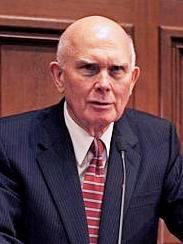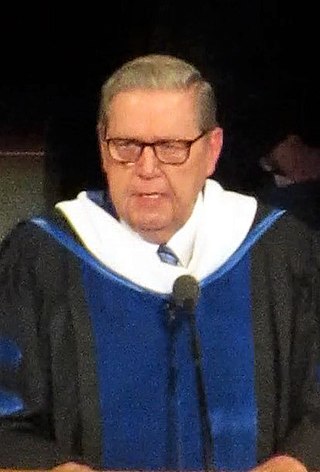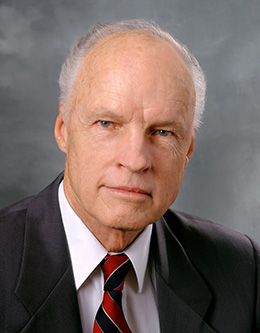
Rex Edwin Lee was an American lawyer and academic who served as the 37th Solicitor General of the United States from 1981 until 1985. He was responsible for bringing the solicitor general's office to the center of U.S. legal policymaking. During his tenure, Lee argued 59 cases before the U.S. Supreme Court.

Dallin Harris Oaks is an American religious leader and former jurist and academic who since 2018 has been the first counselor in the First Presidency of the Church of Jesus Christ of Latter-day Saints. He was called as a member of the church's Quorum of the Twelve Apostles in 1984. Currently, he is the second most senior apostle by years of service and is the President of the Quorum of the Twelve Apostles.

Howard William Hunter was an American lawyer and the 14th president of the Church of Jesus Christ of Latter-day Saints from 1994 to 1995. His nine-month presidential tenure is the shortest in the church's history. Hunter was the first president of the LDS Church born in the 20th century and the last to die in it. He was sustained as an LDS apostle at the age of 51, and served as a general authority for over 35 years.

Jeffrey Roy Holland is an American educator and religious leader. He served as the ninth President of Brigham Young University (BYU) and is a member of the Quorum of the Twelve Apostles of the Church of Jesus Christ of Latter-day Saints. As a member of the Quorum of the Twelve, Holland is accepted by the church as a prophet, seer, and revelator. Currently, he is the fourth most senior apostle in the church.

Marion George Romney was an apostle and a member of the First Presidency of the Church of Jesus Christ of Latter-day Saints.

Joshua Reuben Clark Jr. was an American attorney, civil servant, and a prominent leader in the Church of Jesus Christ of Latter-day Saints. Born in Grantsville, Utah Territory, Clark was a prominent attorney in the Department of State, and Undersecretary of State for U.S. President Calvin Coolidge. In 1930, Clark was appointed United States Ambassador to Mexico.

Ernest Leroy Wilkinson was an American academic administrator, lawyer, and prominent figure in the Church of Jesus Christ of Latter-day Saints. He was president of Brigham Young University (BYU) from 1951 to 1971, simultaneously overseeing the entire LDS Church Educational System (CES). He is credited with the expansion of BYU. Under his presidency, the student body increased six times to over twenty-five thousand students due to the physical growth of the university and his aggressive recruiting policies. The number of colleges at the university increased from five to thirteen and the number of faculty members increased four-fold. Wilkinson focused on recruiting more faculty and convincing current faculty to receive education outside the university. As a result, the number of teachers with doctorate degrees increased from 50 to 500. Associate and doctoral programs were created for BYU.

Howard Stevenson McDonald was President of Brigham Young University (BYU) from 1945 to 1949. During his presidency, the board of trustees approved a master of theology program. Enrollment at BYU greatly increased after World War II, and McDonald petitioned the board of trustees to build many buildings, including the Eyring Science Center. McDonald helped establish the student health center and student wards. He discouraged students from smoking and drinking. He left BYU because of his strained relationship with the board of trustees.

Truman Grant Madsen was a professor of religion and philosophy at Brigham Young University (BYU) and director of the Brigham Young University Jerusalem Center for Near Eastern Studies. He was a prolific author, a recognized authority on Joseph Smith, and a popular lecturer among Latter-day Saints. At one point, Madsen was an instructor at the LDS Institute of Religion in Berkeley, California.

David Fullmer was an American politician, church leader, and farmer, born in Chillisquaque, Pennsylvania. He was the older brother of John S. Fullmer, another politician. Fullmer was a person of some importance in the early Latter Day Saint movement.
Bruce Clark Hafen is an American attorney, academic and religious leader. He has been a general authority of the Church of Jesus Christ of Latter-day Saints since 1996.

Daniel K Judd is an American religious leader and educator who served as the first counselor to A. Roger Merrill in the Sunday School General Presidency of the Church of Jesus Christ of Latter-day Saints from 2004 to 2009. Judd also served as chair of the Ancient Scripture Department of Brigham Young University (BYU). In 2019, Judd was named the Dean of BYU's Department of Religious Education.
Marlin Keith Jensen is an American attorney who has been a general authority of the Church of Jesus Christ of Latter-day Saints since 1989. He served as the official Church Historian and Recorder of the church from 2005 to 2012. He was the 19th man to hold that calling since it was established in 1830. Jensen was made an emeritus general authority in the October 2012 general conference.
Setting apart is a ritual or priesthood action in the Church of Jesus Christ of Latter-day Saints where a person is formally blessed to carry out a specific calling or responsibility in the church.
Arnold Kent Garr was the chair of the department of Church History and Doctrine at Brigham Young University (BYU) from 2006 to 2009. He was also the lead editor of the Encyclopedia of Latter-day Saint History.
Richard Douglas Poll was an American historian, academic, author and member of the Church of Jesus Christ of Latter-day Saints. His liberal religiosity influenced his notable metaphor about "Iron Rod" vs. "Liahona" LDS Church members.

Stephen L. Chipman (1864–1945) was a member of the Utah State Legislature in 1903 and a leader in the Church of Jesus Christ of Latter-day Saints in Utah County. He was also the first president of the Salt Lake Temple who was not also an apostle in the LDS Church.
Lynn Mathers Hilton was an American politician who served as a member of the Utah State Legislature. He was also known as an academic professor, businessman, Middle East explorer and author of many books related to the Church of Jesus Christ of Latter-day Saints.

David John was a leading figure in Utah at the dawn of the 20th century. He served as a stake president in the Church of Jesus Christ of Latter-day Saints and a member of the Brigham Young University (BYU) board of trustees.

Joy Diane Harmon Jones was the 13th Primary general president of the Church of Jesus Christ of Latter-day Saints from 2016 to 2021.











